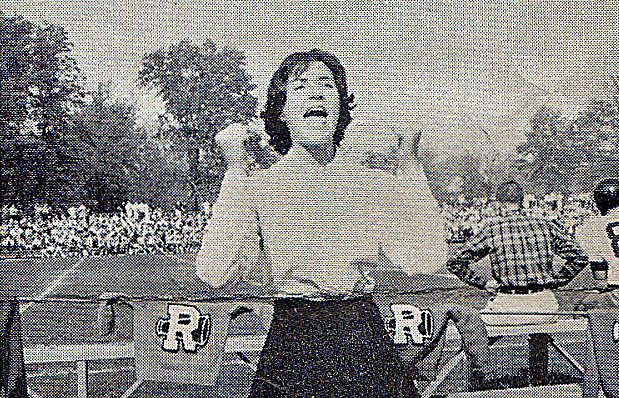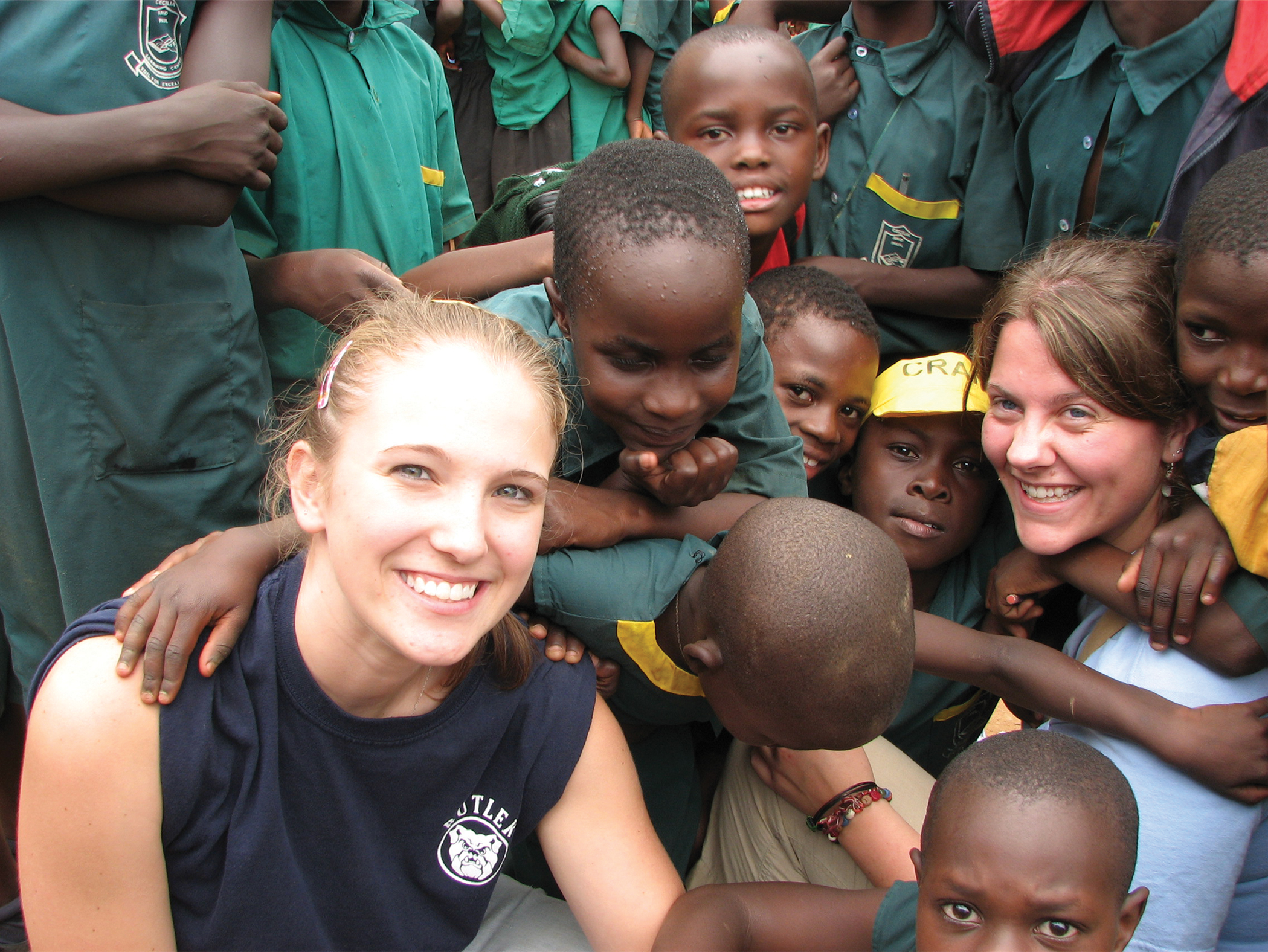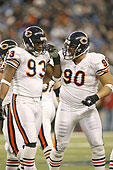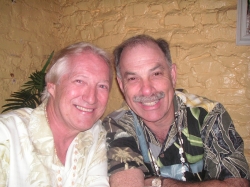
One would hope that the success stories of Featured Alumni may inspire some of the students who follow us. The Rahway News-Record used the banner, "City of homes and industry" to describe our town....blue collar down to its toes. Yet, many who trod the halls of RHS have made an enviable mark; others signal their success in ways other than college degrees and occupations... just good, good folks. The only way to celebrate what Rahway means is to publicize it. To quote a good friend, "Through stories we transmit values, traditions, memories and identity" (underscoring, mine).
Richard A. Moran Is the Tenth President of Menlo College

Richard A. Moran, (RHS 68) President of Menlo College.
July 8, 2014:
The Menlo College Board of Trustees is pleased to welcome Richard A. Moran as the tenth president of Menlo College. Moran, CEO of Accretive Solutions, is a Silicon Valley leader in business and education. As a consultant and operating executive, he is an evangelist for organizational effectiveness. He has authored seven books and is credited with starting the genre of "Business Bullet Books." His most recent book is titled "Navigating Tweets, Feats and Deletes." He is a frequent speaker on workplace issues and hosts a weekend radio show on KCBS called "In the Workplace.”
Menlo College Trustee Geir Ramleth ’87, chair of the presidential search committee said, “Moran brings a very current perspective to Menlo's time-honored legacy as an institution of business education. His instinctive understanding of the modern workplace and his ties to Silicon Valley will be a valuable asset in our partnership with the business community. His creative and innovative approach in identifying trends and norms in the workforce will emphasize that our business curriculum is state of the art.”
He earned an A.B. at Rutgers College, M.S. at Indiana University, and Ph.D. at Miami University, in Oxford, Ohio. Moran was a Partner at Venrock, and at Accenture. In the public sector, he has applied his organizational expertise as Chairman of the Board for Golden Gate University; the Board of Regents at Saint Ignatius Prep; the Steinbeck Innovation Foundation; and Project Open Hand in San Francisco.
Moran serves on boards of the Council of the National Trust for Historic Preservation, the National Association of Corporate Directors, Silicon Valley Chapter, and the Silicon Valley Leadership Group. He is the Chair of the Audit Committee at the Noyce Foundation, and a member of the policy-making group that coordinates the Domain Name System and Internet Protocol addresses.
He has been featured on NPR, in Fast Company, and is a columnist for wine country newspapers. He is a regular contributor as an Influencer on LinkedIn. He and his wife Carol Gilbaugh Moran have four children.
Moran stated, “I could not be happier in assuming the mantle of President at Menlo College. It is a Silicon Valley jewel and I welcome the opportunity to continue to build a great college." Moran begins his position in September 2014.


Shipley, whose connection with the Merchants and Drovers Tavern Museum goes back to 1973, has served as the Director of the Museum Operations since 2008. In his almost forty years as a member he has served as president, vice-president, and trustee and has conceived, developed, organized, and overseen many programs and projects. His contributions include the creation of two publications, Images of the Past (1997) and Images of the Past II (2005) which helped the association reach important fundraising goals. Images II won the 2005 Annual Publication Award given by Historical Societies of New Jersey for “Distinguished Achievement for the Publication of a Book.”

As a writer and producer, he pioneered of the modern infomercial as a TV cooking show host on the PAX Television Network, and the Food Network. The founder of the Health Craft Cookware Company, he is a bestselling cookbook author, and recognized worldwide as the foremost expert on the classic methods of waterless / greaseless cooking.
He received his basic formal culinary training later in life attending the Institute of Culinary Education in New York City and earned credits in Nutritional Cuisine from the Culinary Institute of America in Hyde Park, NY.


Born and raised in a musical family in Rahway, New Jersey, some of Roberson's earliest memories were of his father singing and playing guitar. Eric was singing even as a child, and began performing in earnest as a teenager. He attended Howard University on a Musical Theatre scholarship and performed frequently on campus, while also landing a recording contract with Warner Brothers, for which he recording the R&B hit "The Moon" in 1994.
Following graduation, Roberson gathered a reputation as singer, songwriter and producer, and over the past decade he has worked with a virtual "who's who" of adult soul artists including Jill Scott, Musiq Soul child, Vivian Green, Dwele and Will Downing.
The desire for creative freedom led Roberson to shun major labels and work as an independent for his solo career, beginning with 2001's The Esoteric Movement. Over the next half decade he violated virtually every tenet of conventional wisdom in fashioning one of the most successful independent recording careers. He's released albums when he felt like it, and sometimes reworked and reissued them. He's also sold his CDs principally through his concerts, small retail outlets and CD Baby, resulting in over 100,000 copies sold of his four critically acclaimed albums, The Esoteric Movement, The Vault, Vol 1, The Vault, Vol 1.5, and 2005's The Appetizer.
A tirelessly touring artist, Roberson plays 8-10 sold out concerts each month and is a guest vocalist on countless albums by other artists. He has most recently pioneered the emergence of national tours for indie artists, teaming up with Frank McComb and PJ Morton for a series of concerts that have brought underground soul to the forefront and have paved the way for the genre's increased visibility.
The success of Eric Roberson's activity outside the mainstream has made him a role model for other independent artists and has resulted in a career that continues to build momentum, completely on Roberson's own terms.
Article by Chris Rizik

She grew up as Janis Beam, and has several brothers and sisters; all raised in the Rahway Public Schools.
On April 8, 2005 Karpinski was formally relieved of command of the 800th Military Police Brigade, and on May 5, 2005, President George W. Bush approved Karpinski's demotion to colonel from the rank of brigadier general. Her demotion was not officially related to the abuse at Abu Ghraib prison.
In October 2005 she published an account of her experiences, One Woman's Army, in which she claims that the abuses were perpetrated by contract employees trained in Afghanistan and Guantanamo Bay and sent under orders from Secretary of Defense Donald Rumsfeld, and that her demotion was political retribution.
Article compliments of Herb Freeland '71

Andrea Hollander Budy Class of 1964 was born in Berlin, Germany, in 1947 (of American parents), raised in Colorado, Texas, New York, and New Jersey. A 1964 graduate of Rahway High School, Andrea received her education at Boston University and the University of Colorado.
Since 1977 she has lived in the Ozark Mountains near Mountain View, Arkansas, in a house her husband, Todd, designed and built. Together with their now-grown son, Brooke, they restored and worked as owner-innkeepers of the Wildflower Bed & Breakfast for fifteen years. Since 1991 Budy has been the Writer-in-Residence at Lyon College, where she was awarded the Lamar Williamson Prize for Excellence in Teaching.
Her full-length poetry collections are Woman in the Painting, The Other Life, and House Without a Dreamer, which won the Nicholas Roerich Poetry Prize. Other awards include the D. H. Lawrence Fellowship, a Pushcart Prize for memoir, the Runes Poetry Prize, the Ellipsis Poetry Award, the Porter Prize for Literary Excellence, the WORDS Award, and fellowships from the National Endowment for the Arts, the Arkansas Arts Council, and the Bread Loaf and Wesleyan Writers’ Conferences.

Budy has published more than 200 poems and essays in such literary journals as Crazyhorse, DoubleTake, FIELD, The Georgia Review, The Kenyon Review, Pleiades, Poetry, Shenandoah, The Southern Review, and Sou’wester, which published a special feature on Budy, including an interview, in its spring 2003 issue.
Her work also appears in more than 30 anthologies and textbooks, including Writing Poems; Three Genres: The Writing of Poetry, Fiction, and Drama; The Pushcart Prize: Best of the Small Presses; Conversation Pieces: Poems That Talk to Other Poems; and The Autumn House Anthology of Contemporary American Poetry.
She has given more than 100 readings, lectures, and workshops to audiences of all ages at public and private schools, cultural centers, and libraries, including the New York Public Library, New Hampshire Arts Cooperative, Vassar College, Arizona Western College, University of Arkansas, Shorter College, Texas A& M, College of Charleston, Furman University, Randolph-Macon Woman’s College, and Suffolk University.
Budy has served as Visiting Poet-in-Residence at Westminster College in Salt Lake City, Utah; the University of Burgundy (France); the University of Sussex (England); and St Bede’s School (England).
She has also taught at writers’ conferences, workshops, and institutes, including the White River Writers’ Workshop, which she directed; the Oklahoma Arts Institute; the Taos Summer Writers’ Conference; and Poetry OtherWise at Emerson College in England.
She has been interviewed on National Public Radio, and her work has been featured by Garrison Keillor on his radio program, The Writer’s Almanac, and by former United States Poet Laureates Billy Collins in his Poetry 180 Internet course for high school students, Rita Dove in her Washington Post column, "Poet’s Choice," and Ted Kooser in his syndicated newspaper column, "American Life in Poetry.
Website: http://www.andreahollanderbudy.com

Dr. Gil Herer (RHS Class of 1949), Founder and Senior Global Clinical Advisor to the Special Olympics Healthy Hearing program, was given the Humanitarian Award from the American Academy of Audiology. Dr. Herer was presented with the award to honor his direct humanitarian contribution to society in the realm of hearing and specifically for his contribution to the hearing needs of people with intellectual disabilities.





by Scott Smith
If you're a fan of the group "Chicago," you may be surprised to see Wayne's name on the back of all of their albums (in the credits).
Wayne and Jimmy Guercio both left CBS Records to design and build Caribou Ranch, a recording studio built in a converted barn on ranch property in the Rocky Mountains near Nederland, Colorado, on the road that leads to the ghost town of Caribou. The popular studio was in operation until it was damaged in a March 1985 fire.
Wayne was their recording engineer for many years and has 21 Gold and Platinum Albums to prove it.
He also played several instruments on many of the recordings (he's an incredible musician; sax, piano and bass).
Additionally, he engineered the Hollies Top 10 smash hit "Long Cool Woman in A Black Dress."
Wayne has an EE Degree from NJIT (formerly Newark College of Engineering).
Google "Wayne Tarnowski" for more details on his illustrious musical career.
Some of the artists known to have recorded at Caribou:
America, Badfinger, The Beach Boys, Jeff Beck, Mike Brewer, David Cassidy, Chicago, starting with Chicago VI, Phil Collins, Chick Corea, Rick Derringer, Al Di Meola, Earth, Wind & Fire, Emerson, Lake & Palmer, Sheena Easton, Dan Fogelberg, Jerry Goodman, Jan Hammer, Amy Grant, Waylon Jennings, Billy Joel, Elton John notably the 1974 Caribou album, Carole King, Kris Kristofferson, Robert Lamm, John Lennon Jerry Lee Lewis, Jac Murphy, Michael Murphey, Stevie Nicks, Nitty Gritty Dirt Band, Tony Orlando. Ozark Mountain Daredevils, Tom Petty, Eddie Rabbitt, Bruce Roberts, Sailor, David Sancious, Tom Scott and the L.A. Express, Billy Joe Shaver, Shooting Star (band), Sons of Champlin, Souther Hillman Furay Band Rod Stewart, Stephen Stills, Supertramp, Ali Thomson, U2, James Vincent, Joe Walsh, War, Tony Williams.

Born in Rahway, New Jersey, Gilchrest was the fourth child of Elizabeth and Arthur Gilchrest's six boys. After graduating high school in 1964, he joined the U.S. Marine Corps. His tour of duty saw action during the invasion of the Dominican Republic, and ultimately the Vietnam War. He earned the rank of Sergeant in Vietnam where, as a platoon leader, he was wounded in the chest. Wayne was decorated with the Purple Heart, Bronze Star, and Navy Commendation Medal. Today he is a member of the American Legion, Veterans of Foreign Wars, and Military Order of the Purple Heart.
In 1969, he studied liberal arts at Wesley College in Dover, Delaware, where he received an associate's degree. He then spent a semester in Kentucky studying rural poverty in Appalachia. He went on to receive a bachelor's degree in history from Delaware State College in 1973. Since then, he has done some work towards a master's degree at Loyola College in Baltimore.
Gilchrest defeated 10-year 1st District Democratic incumbent Roy Dyson in 1990 and has been reelected seven times without significant opposition. Gilchrest defeated Democratic opponent Jim Corwin in the 2006 Congressional race.
Read more about Wayne Gilchrest @ http://en.wikipedia.org/wiki/Wayne_Gilchrest


O'Brien was at Jacksonville State University in Alabama, double majoring in History and Political Science, when he was drafted at the end of his four years of college because a college deferment was only good for four years. In 1969, he voluntarily enlisted in the United States Army. "Not a lot of helicopter pilots were signing up so my recruiter was pleased," O'Brien said.
O'Brien did his basic training at Fort Polk in Louisiana. From there he went right to warrant officer and primary flight school at Fort Wolters, outside of Dallas, Texas. There he was trained on a two-seated helicopter in basic flight instruction.
After flight school, O'Brien went to Fort Rucker in Alabama for secondary flight school where he transitioned to the Huey, a much larger aircraft than what he learned to fly in primary school. While at Fort Rucker, he participated in tactical flight school where he learned formation flying and combat assaults.
Unfortunately, the mission was deemed unsuccessful, as the South Vietnamese troops were surrounded in the valley where they were located. The troops were originally deployed in Laos and they moved into enemy territory. "From an infantry standpoint, it’s not a good spot to be in," O'Brien said.
The undersides of the pilot seats were made bulletproof to protect the pilot and a panel near the side window was equipped with a bulletproof shield. On that mission, it did not help, however, since the North Vietnamese troops were positioned at the top of the valley. "Trying to get the troops out of the valley was not the easiest thing in the world," O'Brien said. When the unit tried to land, the area was too hostile and the helicopter had to hover 10 feet above the ground while the soldiers climbed on top of each other to get into the chopper.
"People were knocking other people down to get into aircraft; they were in a panic," said O'Brien. "When they got in the aircraft, they didn't have anything with them, not even their weapons."
O'Brien left Vietnam in December 1972 when his tour of duty was done. After his involvement in the war, he took his last class in order to get his degree.
He served 12 years in the Army, two-and-half in active duty and the rest in the reserves. After almost a decade in the reserves, O'Brien had to drop out because his job required too much traveling.
Today, O'Brien is retired and resides in Gilford, N.H. He is vice-chair of the Gilford Budget Committee, serves as a commissioner of the Gunstock Village Water District, is a trustee in the Gunstock Acre Trust and is a member of the town's facility planning committee.
Article compliments of Vic Jones class of 64

Bush, who’s been affected by spinal muscular atrophy since childhood and who uses a motorized wheelchair, went to work for MDA in 1994.
After much public debate, it was decided that a statue of FDR in his wheelchair would indeed be included in the memorial, giving credence to the belief of Tom and others that the reality of FDR’s disability should be a visible part of his historical legacy.

A Pulitzer Prize winner for the book The Dragons of Eden: Speculations of the Evolution of Human Intelligence, Dr. Sagan was the author of many bestsellers, including Cosmos, which became the bestselling science book ever published in English. The accompanying Emmy and Peabody award-winning television series has been seen by a billion people in sixty countries. He received twenty-two honorary degrees from American colleges and universities for his contributions to science, literature, education, and the preservation of the environment, and many awards for his work on the long-term consequences of nuclear war and reversing the nuclear arms race. His novel, Contact, is now a major motion picture.
Born in Brooklyn to a Jewish family, his father, Sam Sagan, was a garment worker; his mother, Rachel Molly Gruber, a housewife. After graduating from RHS, he attended the University of Chicago, where he received a B.A. with special honors in 1955, a B.S. in 1955 and a M.S. in physics in 1956, and his Ph.D. in astronomy and astrophysics in 1960. During his time as an undergraduate, Sagan worked in the laboratory of the geneticist H. J. Muller, and from 1960 to 1962 he was a Miller Fellow at the University of California, Berkeley. He worked at the Smithsonian Astrophysical Observatory in Cambridge, Massachusetts from 1962 to 1968
Sagan was a leader in the U.S. space program since its inception. From the 1950s onward, he worked as an adviser to NASA. One of his many duties included briefing the Apollo astronauts before their flights to the Moon. Sagan contributed to most of the robotic spacecraft missions that explored the solar system, arranging experiments on many of the expeditions. He conceived the idea of adding an unalterable and universal message on spacecraft destined to leave the solar system that could be understood by any extraterrestrial intelligence that might find it. Sagan assembled the first physical message that was sent into space: a gold-anodized plaque, attached to the space probe Pioneer 10, launched in 1972, Pioneer 11, also carried Sagan’s plaque in 1973. He continued to refine his designs throughout his lifetime; the most elaborate message he helped to develop and assemble was the Voyager Golden Record that was sent out with the Voyager space probes in 1977.
At Cornell, Sagan taught a course on critical thinking until his death in 1996 from a rare bone marrow disease. The course had only a limited number of seats. Although hundreds of students applied each year, only about 20 were chosen to attend each semester. The course was discontinued immediately after Sagan's death, but was later resumed by Professor Yervant Terzian in 2000.
In their posthumous award to Dr. Sagan of their highest honor, the National Science Foundation declared that his "research transformed planetary science… his gifts to mankind were infinite."
Carl Sagan was posthumously inducted in to the NJ Hall of Fame… The presentation to his widow and sons was given by Astronaut “Buzz” Aldren.
Dr. Sagan's surviving family includes his wife and collaborator of twenty years, Ann Druyan; his children, Dorion, Jeremy, Nicholas, Sasha, and Sam; and grandchildren.
Source: http://en.wikipedia.org/wiki/Carl_Sagan and http://www.carlsagan.com

Throughout high school and Montclair State College, Vaché eagerly sought out all kinds of gigs, playing with the Rahway High dance band, as well as at weddings, bar mitzvahs, and receptions. As a college music major, he began to find the formal training stultifying and through his father met trumpeter Pee Wee Erwin, who had been a star performer with the best bands of the swing era, including Benny Goodman and Tommy Dorsey.


Friedman was awarded a competitive scholarship to Rutgers, graduating with a BA in 1932. He specialized in Mathematics and initially intended to become an actuary but found the exams cumbersome and quit. During his time at Rutgers, Friedman fell under the influence of two economics professors, Arthur F. Burns and Homer Jones. At the height of the Great Depression, they convinced him that the study of Economics could help to solve the ongoing economic difficulties, and he ended up graduating with the equivalent of a double major in Mathematics and Economics.


Kagan is one of the key pioneers of developmental psychology. Daniel and Amy Starch Research Professor of Psychology, Emeritus at Harvard University, he has shown that an infant's "temperament" is quite stable over time, in that certain behaviors in infancy are predictive of certain other behavior patterns in adolescence.
In an empirical study by Haggbloom et al using six criteria such as citations and recognition, Kagan was found to be the 22nd most eminent psychologist of the 20th Century, just above Carl Jung.
Kagan was born in Newark in 1929, and graduated with honors from Rahway High School in 1946. He earned a B.S. degree from Rutgers University in 1950. In 1951 he married Cele Katzman, and they have one daughter. Kagan earned his master's degree from Harvard University and his Ph.D. from Yale University in 1954. He spent a year as an instructor in psychology at Ohio State University. After two years as a psychologist at the U.S. Army Hospital at West Point, he did research in developmental psychology at Ohio's Fels Institute (1957-64) before beginning his career at Harvard University.
He is the author of Personal Development (1971), Growth of the Child (1978), and The Nature of the Child (1982).
Jerome Kagan's book "Galen's Prophecy: Temperament in Human Nature" is a bestseller.

Born in the United States to Norwegian immigrants, Evie began her singing career as a young teenager while visiting her parents' homeland. She released her English language debut album at the age of 16 in 1974,and went on to release more than 30 albums, including several in various Scandinavian languages.Evie was recognized as the Dove Award recipient of Female Vocalist of the Year for 1977 and 1978.She married Swedish pastor and musician Pelle Karlsson in 1979 and retired from performing music in 1981 to pursue other avenues of ministry, such as Sky Angel.Evie later became a mentor to Christian musician Rebecca St. James, joining her for an event series geared toward helping girls and women apply biblical principles in the 21st century.
Evie was officially inducted into the Gospel Music Hall of Fame on February 22, 2005,and was one of the inaugural inductees to the Christian Music Hall of Fame.


